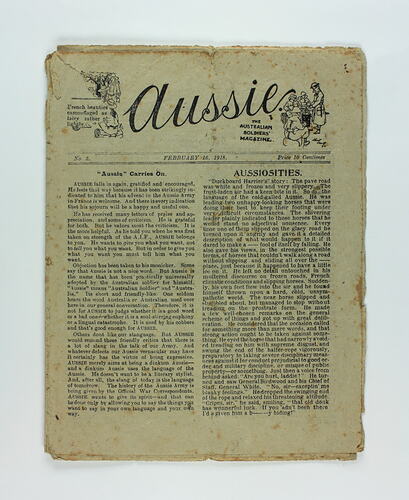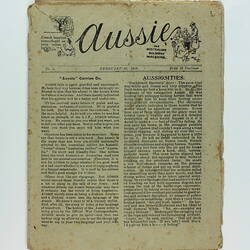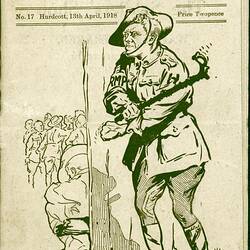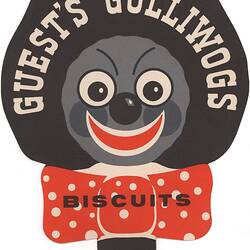Summary
Issue no. 2, February 1918, of World War I-era publication titled 'Aussie', 'The Australian Soldiers' Magazine'. Printed in the field by the AIF Printing Section. The issue is missing its cover, which can be seen on ST 037579.
One of a collection of copies of 'Aussie' magazines in Museum Victoria's collection dated 5 June 1918 - 15 January 1929.
'Aussie' (1918- circa 1929) was a commercial magazine of opinion, review and entertainment. It was edited by Phillip Harris and published in France 1918 - 1919 on a small printing press that Harris brought with him to France. Initially the print run was only 10,000 copies, but soon it reached 60,000 and later 100,000. The magazine aimed to celebrate a distinctive 'Aussie' identity through language, humour and imagery. It distributed news, provided light-hearted ways of seeing the war experience and gave soldiers an outlet to express dissent or dissatisfaction. It also provided a voice for Australian authors such as Banjo Paterson, C.J. Dennis and Bernard O'Dowd. The magazine also frequently contained deeply racist and sexist imagery and references.
After the war, Phillip Harris produced a monthly in Sydney and renamed it 'Aussie: the Cheerful Monthly' from 1920. It built a sizeable circulation and for several years it published the major Australian writers and cartoonists of the day. It set out to sustain the digger culture and defend the rights of the veterans, while also embracing the re-adjustment of returned soldiers into civilian life.
'Aussie' magazines frequently portray cultural and racial groups in a derogatory way in order to amuse readers. Nicknames and terms of ridicule are used to describe a 'stereotypical' person of British, German, African American, First Peoples (Australia) or Chinese background. In addition an exaggerated accent from the targeted person or nationality comes across in the dialogue which accompanies many cartoons.
Physical Description
Magazine printed on four pieces of A4 paper folded at the centre to form16 pages. Text and illustrations printed in black ink
Significance
This object provides an Australian soldiers' view of the political and world climate during World War I, and also represents the bond between Australian soldiers. The magazine celebrated a distinctive 'Aussie' identity, through language, humour and their assertion of what it meant to be an Australian. It allowed news to be distributed, gave the soldiers an outlet to express any dissent or dissatisfaction, thus preventing any greater form of rebellion and promoted Australian authors like Banjo Paterson, C.J. Dennis and Bernard O'Dowd. After the war, Phillip Harris produced a monthly in Sydney from 1920 and renamed it: 'Aussie: the Cheerful Monthly'. It built a sizeable circulation and for more than a decade it published the major Australian writers and cartoonists of the day. It set out to sustain the digger culture and defend the rights of the veterans, while also embracing the re-adjustment of returned soldiers into civilian life.
'I claim no credit for the success of Aussie. That belongs to the Diggers. Aussie was not a paper done for the Diggers, but by them. That's why it reflects their spirit.' - Phillip L. Harris, Editor, taken from 'The Story of Aussie'
More Information
-
Collection Names
Military Memorabilia Collection, Returned and Services League (RSL) Collection
-
Collecting Areas
-
Acquisition Information
Donation & Subsequent Transfer from Mrs O. Corke
-
Publisher
Printing Section, Australian Imperial Force (AIF), France, 16 Feb 1918
-
Editor
-
Format
Journal
-
Inscriptions
Printed on front page: Aussie/THE AUSTRALIAN/SOLDIERS'/MAGAZINE./ No 2 FEBRUARY 1918. Price 10 Centimes/"Aussie Carries On. AUSSIEOSITIES. [extensive text]
-
Classification
-
Category
-
Discipline
-
Type of item
-
References
Amanda Laugesen, (2003) 'Aussie Magazine and the Making of Digger Culture during the Great War' National Library of Australia News (November), pp.15-18
-
Keywords
Militaria: Australian, Military Memorabilia, Magazines, World War I, 1914-1918, Cultural Stereotypes




